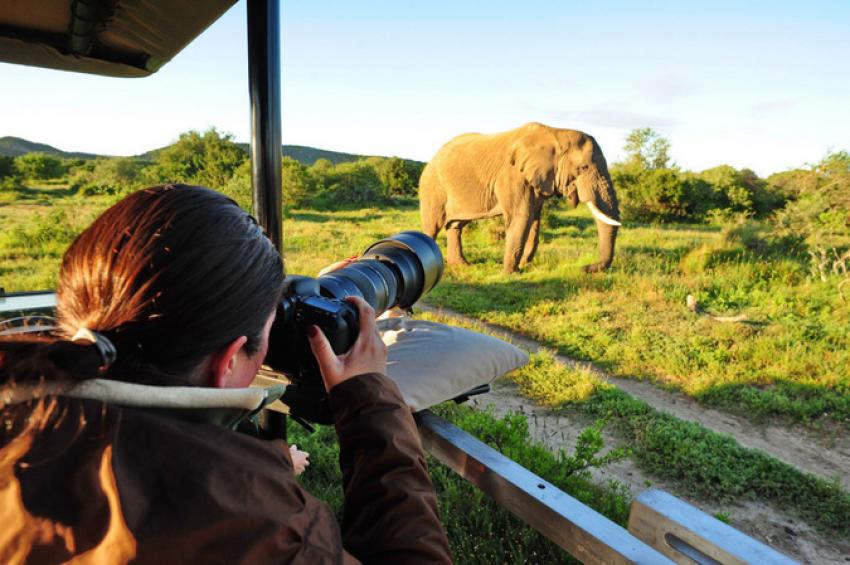Capturing moments with our cameras and smartphones are becoming a part of everyone’s daily routine. And with Africa’s mesmerizing landscapes, incredible textures and supersize wildlife, going on a safari without a camera seems sacrilege. In fact, photographic safaris are becoming increasingly popular these days that cameras are high on everyone’s “Must Pack” list. So if you want that perfect Kodak moment while on safari, it’s important to know what to pack, when to go and what conditions are going to be. Here, we have put together some handy tips for an incredibly photographic safari – perfect for beginners and professionals alike!
Tip 1: Bring the right camera…
There are a lot of cameras in the market that would make exemplary gears to capture the magic of your safari or trek. But, before you decide which camera to purchase or to bring, there are some features you need to know.
- Durability: Is it waterproof? Dust-proof? Shockproof? Most roads during game drives are dusty. Even on walking tours, the dry dirt blows in the wind. Hence, a dust-proof camera is definitely most needed. Also, rain is a huge factor to consider even though most parts of Africa do not particularly get high chances of precipitation. Especially if you’re on a trek, for example to see mountain gorillas or chimps, or if you go around April and May in Tanzania, getting caught in a downpour is absolutely likely. And remember, when it rains in the jungle, it pours. For shock, it’s just something you need to consider. Even though your camera will most likely be strapped on your neck, accidents can still happen. Just make sure it’s a really durable camera.
- Weight and size: Remember that during game drives and adventure treks, baggage that you can bring are limited to a certain weight. If you bring a heavy camera with too many gears and/or paraphernalia, you’ll be left with little space for your other important things like water, extra shirts and whatnot. Also, it would be more convenient (and less painful on the neck or shoulders) to bring a compact and lightweight camera. So while these types of cameras may mean you’ll have to sacrifice some features, you’ll just have to balance it with image quality.
- FPS (Frames Per Second): If you shoot on landscape, steady wildlife and slow-moving creatures, high FPS is not a requirement. However, capturing fast-moving animals and birds need high FPS. On a safari, you will be able to encounter a lot of quick animals. If you’re lucky, you may even catch cheetahs running around, lions chasing preys, or endemic birds flying by.
- Battery life: A good battery life is always a good idea. Since you will probably be shooting almost nonstop, you may also consider getting additional batteries or bringing fully-charged power banks.
- Sensor size: This has a huge influence on photo quality. Cameras with a high quality sensor is highly recommended.
- Connectivity: This is not really a huge thing but if you want to transfer your files easily, or be up to date with your followers on Instagram, Facebook or Twitter, cameras featuring WiFi with NTC or bluetooth may be most ideal.
FAQ: How about action cameras like GoPro? These types of cameras can be great and can capture fun memories and produce good enough photos, but these aren’t exactly the best camera for safari photography. Their close-ups are quite good, they aren’t exactly known for their zoom.
Tip 2: …and the right lens.
Zoom capability and wide angle lens are things you need to keep in mind. Especially when shooting wildlife, there will be plenty of animals that will be at a far distance during your safari. If you want good pictures, you need a camera with better zoom, something that will allow you to capture the details your naked eye is missing out on. Now, when capturing landscapes, wide angle lens is best. The problem is, the wider the angle of the lens, the less zoom it has. The solution? Bring at least 2 lenses! Short length lenses (less than 50mm) are best for landscapes, and long length lenses (135mm and up) are best for close ups. If you have the budget, you can also go for lenses with a reach of at least 200mm. This would totally make you a rockstar in safari photographing!
Tip 3: Know what to expect.
Early morning game drives are usually cold so make sure to wear something appropriate (and OOTD ready). Animals are most active during this time of day and landscape is also very stunning especially when that ray of sunshine starts to kiss the savannas a very good morning. For afternoon or evening game drives, expect to catch the glorious sunset and to enjoy some sundowners. Hint: great photo opportunities to shoot at Golden Hour!
Tip 4: Let that shutter fly.
In photography, it is often quality that will increase your chances of ending up with quality. So take as much pictures as you can. Be trigger happy, if you please. Thanks to memory cards, extra batteries and power banks, capturing (and storing) thousands of images is made possible.
Tip 5: Prepare your inner Annie Leibovitz or David Maitland when you see water.
Here’s the thing about safari photography: When there’s water, there’s wonder. It is natural for animals to congregate around waterholes. It is also very possible for wildlife to exhibit drama in these areas – predator versus prey or predator versus predator. If you go to rivers like Mara and Grumeti, you’ll surely witness spectacular wildlife moments. All these create unbelievable photographs so get ready.
Tip 6: Know when to go.
If you’re after photographing certain events or animals, you need to know the “safari calendar of events”. Although Africa is teemed with wildlife year-round, there are certain times or months that highlight particular wildlife events and/or animal sightings.
For example, in Tanzania, you can catch the Great Wildebeest Migration on different areas of the Serengeti ecosystem depending on the month/season you visit. If you want to see the intense Mara river crossing, this usually happens around July through October. For Grumeti river crossing, you can see this in the Western Corridor around June. For calving season wherein wildebeests give birth to thousands of youngsters each day and predators take advantage of such event, it is best to see this in January until early March.
Other important times to remember are June to October, Tanzania’s driest months. During these months, animals congregate around watering holes and vegetation is not lush so wildlife viewing is at its prime. Migratory birds also arrive in Tanzania around April and leave in November. So it really depends on what you want to see, or photograph for your African safari tours.
These are the best tips for you to capture the magic of your safari or trek. Always remember, a true African experience in the bush of Tanzania is a moment worth capturing. Check these picture-perfect Tanzania safari packages to get browse unforgettable, un-missable safari adventures.

 1-321-766-6821
1-321-766-6821 


